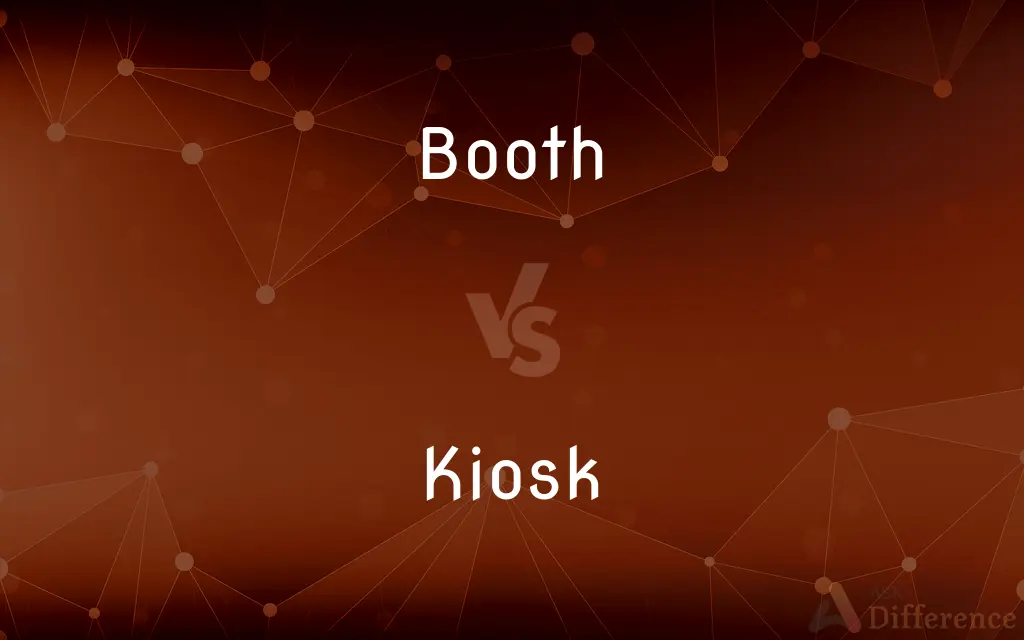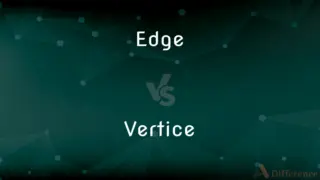Booth vs. Kiosk — What's the Difference?
By Maham Liaqat & Fiza Rafique — Updated on April 29, 2024
A booth typically refers to a small, temporary structure or enclosure, often used for voting, exhibitions, or sales, while a kiosk is a small, stand-alone structure often used in malls and public areas for selling goods or providing information.

Difference Between Booth and Kiosk
Table of Contents
ADVERTISEMENT
Key Differences
A booth is commonly used for specific events and purposes like trade shows, food service, or as temporary quarters within a larger venue. Whereas a kiosk is typically a permanent or semi-permanent fixture found in high-traffic areas like shopping malls, airports, or urban streets, designed for retail or informational services.
Booths are designed to be assembled and disassembled easily, making them ideal for temporary events. They often provide privacy or separation from a larger environment, useful in settings like voting or health screenings. On the other hand, kiosks are usually more robust and secure, equipped to handle continuous use and often feature built-in technology such as touch screens or computers.
In terms of size and design, booths can vary widely, ranging from simple table setups to elaborate, enclosed spaces that are customized for exhibitions or promotional activities. Kiosks, however, are generally smaller and more standardized, optimized for efficient use of space and user accessibility in public areas.
The primary function of booths is often to provide a space for personal interaction or privacy, accommodating activities like consultations, exhibitions, or interviews. In contrast, kiosks focus on commercial transactions or information dissemination, such as selling tickets, snacks, or providing tourist information.
Booths are a staple in fairs, exhibitions, and voting contexts, where they serve practical purposes for short durations. Kiosks, meanwhile, are integral to modern consumer environments, facilitating easy access to goods and services in daily public life.
ADVERTISEMENT
Comparison Chart
Primary Use
Temporary events, privacy for specific activities
Permanent retail and information services
Location
Event venues, fairs, markets
Malls, airports, public spaces
Construction
Portable, easy to assemble and disassemble
More permanent, often secured to the ground
Design Flexibility
Highly variable, often customized
Smaller, more standardized
Function
Personal interaction, exhibitions
Retail sales, information distribution
Compare with Definitions
Booth
A small temporary tent or structure at a market, fair, or exhibition, used for selling goods, providing information, or staging shows.
She set up a colorful booth at the craft fair to sell her handmade jewelry.
Kiosk
A small structure in a public area used for selling goods or providing information.
Tourists gathered around the kiosk to buy tickets for the city tour.
Booth
A small enclosure that provides privacy for the user, often used for voting or taking photographs.
Voters entered the booth to cast their ballots in privacy.
Kiosk
Often equipped with technology, such as touch screens for self-service in places like airports and malls.
She used the airport kiosk to check in and print her boarding pass quickly.
Booth
A small, often temporary space set aside for specific activities, especially in a larger venue.
The health fair featured several medical booths offering free screenings.
Kiosk
Designed to be a compact, efficient space for business transactions.
The mall’s new kiosk sells artisan chocolates and gourmet snacks.
Booth
Used in exhibitions and trade shows to display and promote products or services.
The company designed an interactive booth for the trade show to demonstrate their new technology.
Kiosk
An open-fronted cubicle from which newspapers, refreshments, tickets, etc., are sold.
He stopped at the kiosk to buy a newspaper and a cup of coffee.
Booth
A fixed, enclosed seating area in a restaurant or bar, separated from other diners.
They requested a booth at the restaurant for a more intimate dining experience.
Kiosk
A permanent or semi-permanent fixture in public venues, optimized for high traffic.
The information kiosk at the park provides maps and guides to visitors.
Booth
A small, often enclosed compartment, usually accommodating only one person
A voting booth.
Kiosk
Historically, a kiosk (from Persian kūshk) was a small garden pavilion open on some or all sides common in Persia, the Indian subcontinent, and in the Ottoman Empire from the 13th century onward. Today, several examples of this type of kiosk still exist in and around the Topkapı Palace in Istanbul, and they can be seen in Balkan countries.
Booth
A small enclosed compartment with a window, used to separate the occupant from others
A ticket booth.
Kiosk
A small structure, usually open in front, used as a newsstand or a place for selling goods or conducting transactions, as at a bank.
Booth
A seating area in a restaurant with a table and seats whose high backs serve as partitions.
Kiosk
A small structure housing an electronic terminal for public use, as for purchasing tickets or accessing information.
Booth
A small stall for the display and sale of goods.
Kiosk
A usually cylindrical structure on which advertisements are posted.
Booth
A small stall for the display and sale of goods.
Kiosk
(Archaic) A small open gazebo or pavilion.
Booth
An enclosure just big enough to accommodate one standing person.
Kiosk
A small enclosed structure, often freestanding, open on one side or with a window, used as a booth to sell newspapers, cigarettes, etc.
Booth
An enclosed table with seats, as in a diner or café.
Kiosk
A similar unattended stand for the automatic dispensing of tickets, etc.
Booth
An enclosure for keeping animals.
Kiosk
A public telephone booth.
Booth
A house or shed built of boards, boughs, or other slight materials, for temporary occupation.
Kiosk
A Turkish garden pavilion.
Booth
A covered stall or other temporary structure in a fair, or market, or at a polling place.
Kiosk
A Turkish open summer house or pavilion, supported by pillars.
Booth
A partly enclosed area within a room for use of one or a small number of people, such as one in a restaurant having a table and seats, or one at an exhibition containing a display of products from one organization.
Kiosk
A light ornamental structure used as a news stand, band stand, etc.
Booth
A small structure designed for the use of one person performing a special activity; as, a telephone booth; a highway toll booth; a projection booth; a guard booth.
Kiosk
A small roofed structure, typically located on a sidewalk and sometimes in a parking lot, with one or more open sides, used to vend merchandise, such as newspapers or beverages, or services, such as key duplication or film developing.
Booth
A table (in a restaurant or bar) surrounded by two high-backed benches
Kiosk
Small area set off by walls for special use
Booth
Small area set off by walls for special use
Booth
United States actor and assassin of President Lincoln (1838-1865)
Booth
A small shop at a fair; for selling goods or entertainment
Common Curiosities
What is the main difference between a booth and a kiosk?
The main difference lies in their usage and permanence; booths are typically temporary and used for specific events, while kiosks are more permanent and used primarily for retail or information services.
Which is more secure, a booth or a kiosk?
Kiosks tend to be more secure, often being permanent and designed to handle public interaction continuously, including secure transactions.
Can either booths or kiosks be customized?
Both can be customized, though booths offer more flexibility in design for specific events, whereas kiosks might have some constraints due to their standardization and need for durability.
What materials are typically used to construct booths and kiosks?
Booths are often made from lightweight materials for easy assembly, such as fabric, plastic, or light metal. Kiosks are built from more durable materials suited for long-term use, like metal, wood, or reinforced plastics.
Can booths be used for selling products like kiosks?
Yes, booths can be used for selling products, especially at fairs, markets, or exhibitions, although they are usually temporary setups.
Are kiosks always digital?
Not always, but modern kiosks often incorporate digital technology to facilitate transactions and information dissemination.
How does technology integrate into kiosks?
Technology in kiosks can range from simple payment processing systems to complex interactive touch screens that provide services like check-in, ticketing, and informational displays.
How do booths and kiosks impact consumer experience?
Booths enhance consumer experience by providing a dedicated space for interaction and personalized service, while kiosks offer convenience and quick access to products or information.
Where are kiosks and booths most commonly found?
Booths are commonly found at trade shows, fairs, and events, while kiosks are frequently located in malls, airports, and urban public spaces.
Are there different types of booths?
Yes, there are various types of booths, including exhibition booths, voting booths, and food booths, each designed for a specific purpose.
Is there an environmental impact difference between booths and kiosks?
Booths, being temporary, often have a lower long-term environmental impact compared to kiosks, which require more materials and energy for construction and operation.
Which is more cost-effective for a startup business?
Booths can be more cost-effective for startups due to their lower initial investment and flexibility, ideal for testing products in different markets.
What are some common uses for kiosks?
Common uses include selling tickets, providing tourist information, and facilitating quick retail transactions, such as in fast-food or coffee sales.
How do booths and kiosks contribute to business operations?
Both contribute significantly by enhancing brand visibility and customer engagement, booths through event-specific exposure and kiosks through everyday consumer interaction.
How can one maximize the effectiveness of a booth or kiosk?
Maximizing effectiveness involves good design that attracts attention, strategic placement to ensure high visibility, and offering tailored services or products that meet the needs of the target audience.
Share Your Discovery

Previous Comparison
Edge vs. Vertice
Next Comparison
Permissible vs. AllowableAuthor Spotlight
Written by
Maham LiaqatCo-written by
Fiza RafiqueFiza Rafique is a skilled content writer at AskDifference.com, where she meticulously refines and enhances written pieces. Drawing from her vast editorial expertise, Fiza ensures clarity, accuracy, and precision in every article. Passionate about language, she continually seeks to elevate the quality of content for readers worldwide.
















































